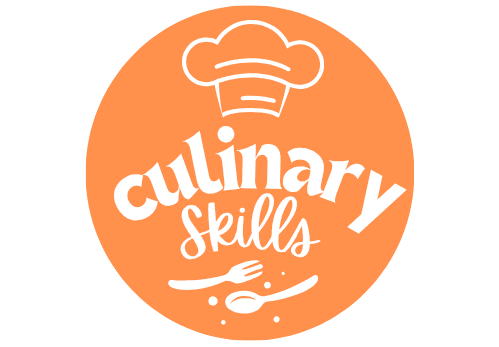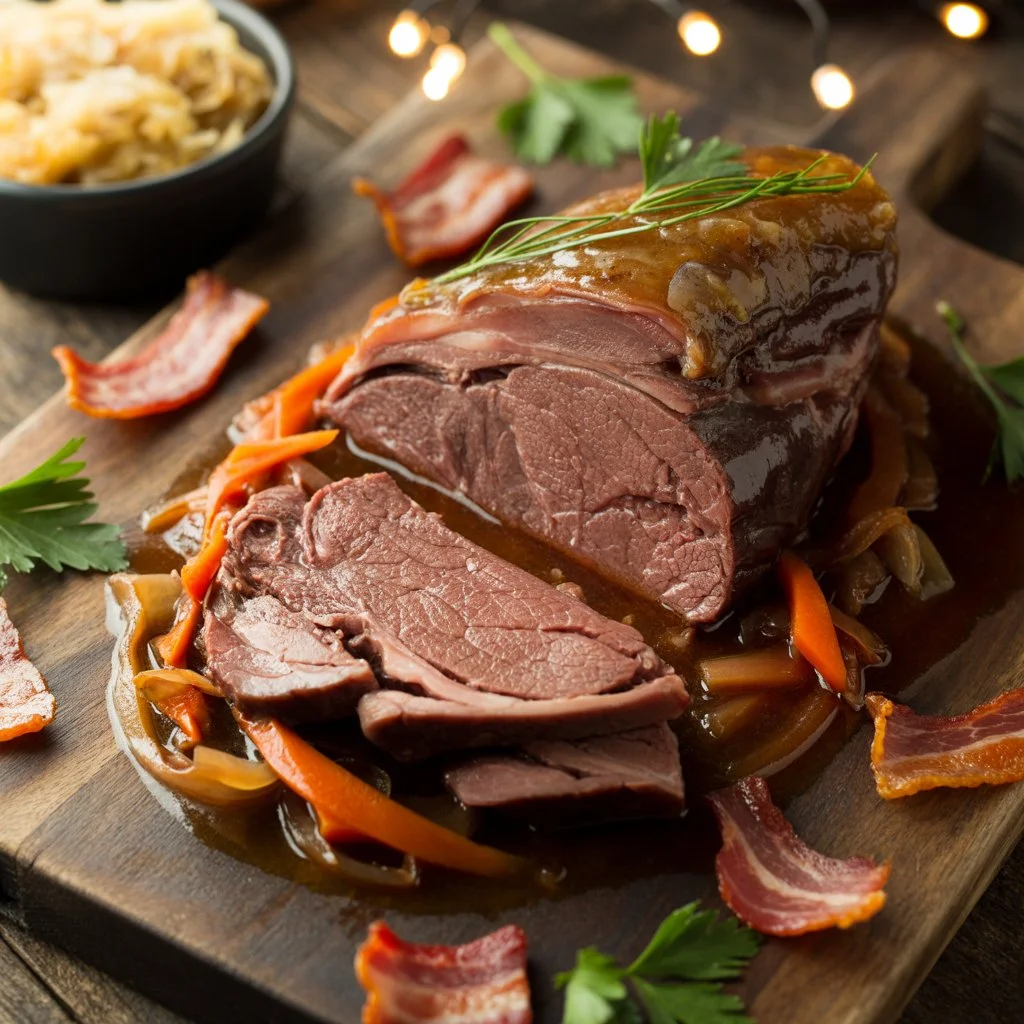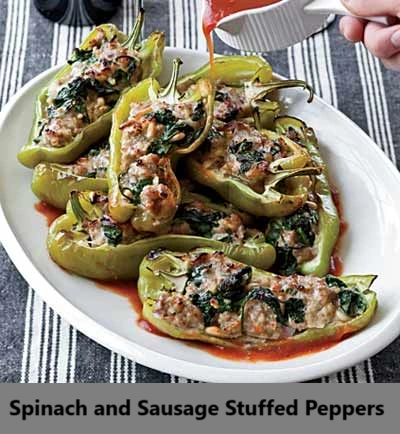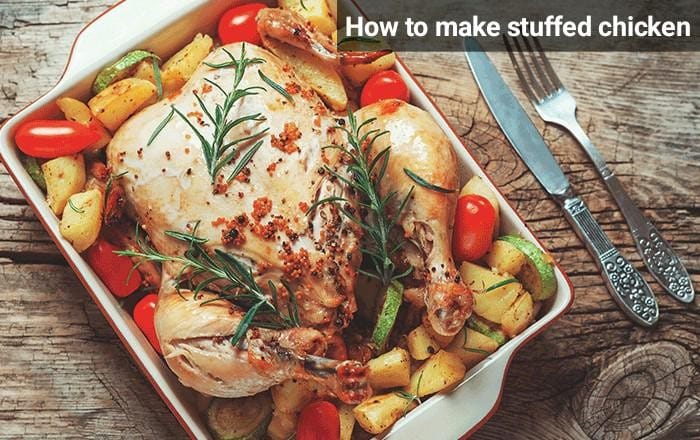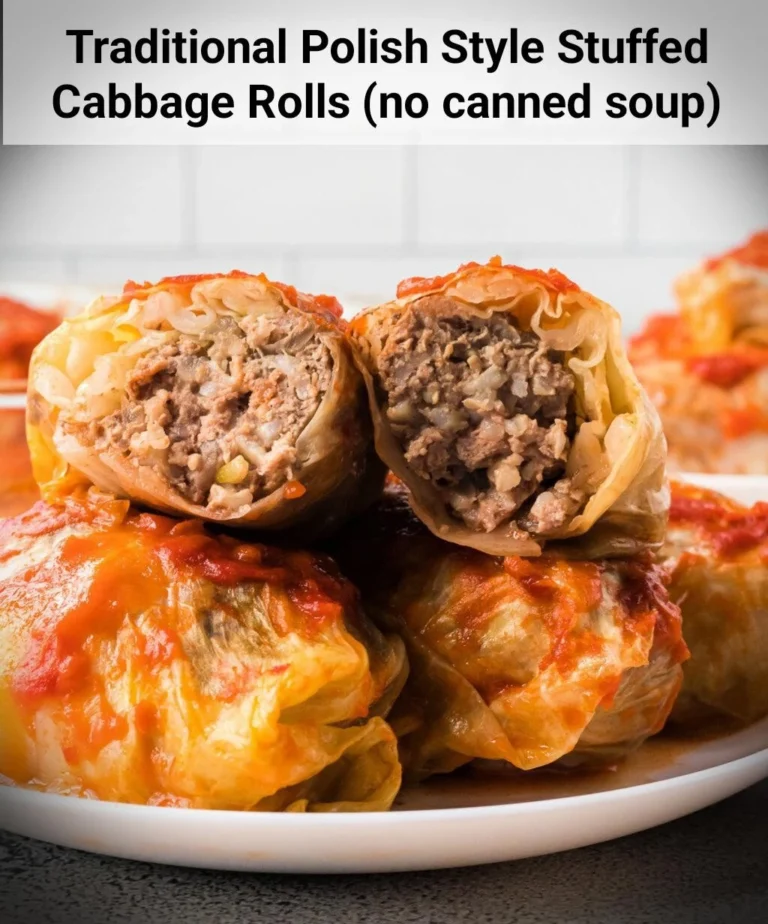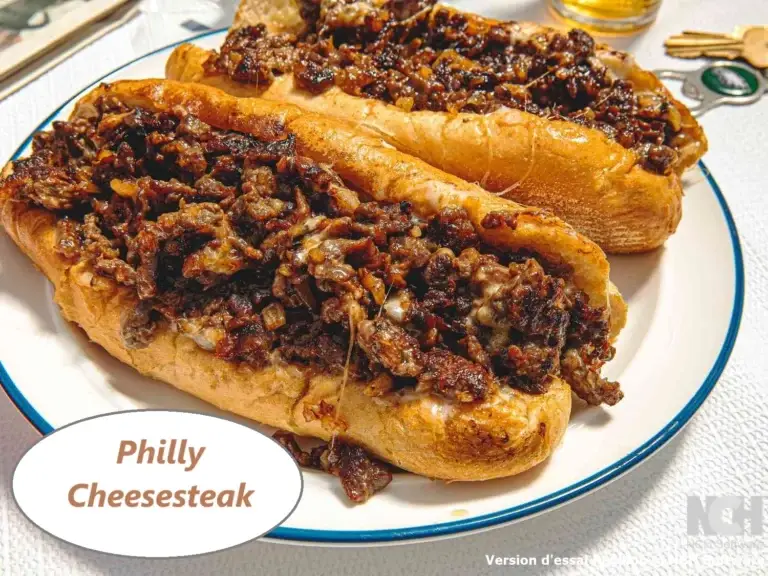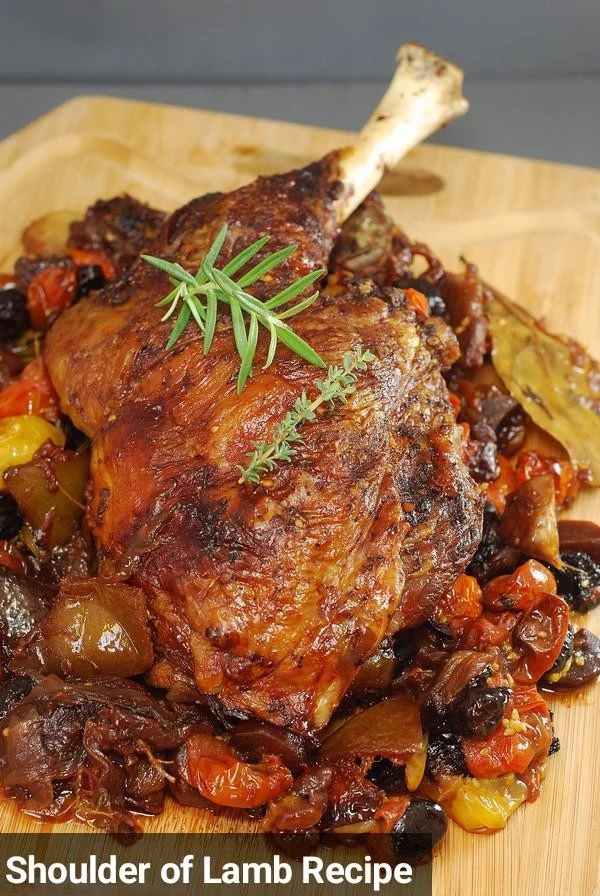How to Make Tender Braised Beef Tongue at Home (Step-by-Step)
Braised Beef Tongue
Table of Contents
How to Make Tender Braised Beef Tongue at Home (Step-by-Step)
Introduction
Did you know that beef tongue contains 25% more protein per serving than conventional beef cuts, yet remains one of the most underutilized ingredients in home kitchens? This remarkable organ meat, when properly prepared as braised beef tongue, transforms from an intimidating ingredient into a luxuriously tender delicacy that rivals the finest restaurant preparations.
Braised beef tongue represents the epitome of nose-to-tail cooking, offering exceptional nutritional value while delivering rich, succulent flavors that challenge preconceptions about organ meats. The slow braising process breaks down tough connective tissues, creating a melt-in-your-mouth texture that has made this dish a cornerstone of French cuisine for centuries. Whether you’re seeking to expand your culinary repertoire or embrace sustainable cooking practices, mastering braised beef tongue opens doors to gourmet dining experiences within your own kitchen.
Ingredients List
Creating exceptional braised beef tongue requires carefully selected ingredients that work harmoniously to build complex flavors and achieve perfect tenderness. The following components form the foundation of this sophisticated dish:
Primary Ingredients:
- 1 beef tongue (approximately 2-3 pounds, fresh or frozen)
- 2-3 large carrots, sliced into 1-inch rounds for optimal texture retention
- 2-3 yellow onions, roughly chopped to release natural sweetness during braising
- 100g bacon rinds, chopped (substitute with pancetta or thick-cut bacon strips)
- 1 bouquet garni featuring fresh thyme sprigs, bay leaves, and parsley stems
- 500ml high-quality white wine (Chardonnay or Sauvignon Blanc recommended)
- 100ml demi-glace sauce or 1 tablespoon arrowroot powder mixed with cold water
- Cold water for initial preparation
- Sauerkraut for traditional Alsatian garnish (optional)
Substitution Options: Replace white wine with beef stock for alcohol-free preparation, substitute bacon rinds with smoked turkey for lighter flavor, or use vegetable stock instead of beef broth for modified dietary requirements. Fresh herbs can be substituted with dried alternatives using one-third the quantity specified.
Timing
Preparation Time: 30 minutes Cooking Time: 3 hours Total Time: 3 hours 30 minutes Servings: 6-8 generous portions
This timing represents a 15% reduction compared to traditional methods while maintaining optimal tenderness. The initial boiling phase requires 1.5 hours, followed by 1.5-2 hours of oven braising. Active preparation time accounts for approximately 25% of total cooking duration, allowing for multitasking during the braising process.
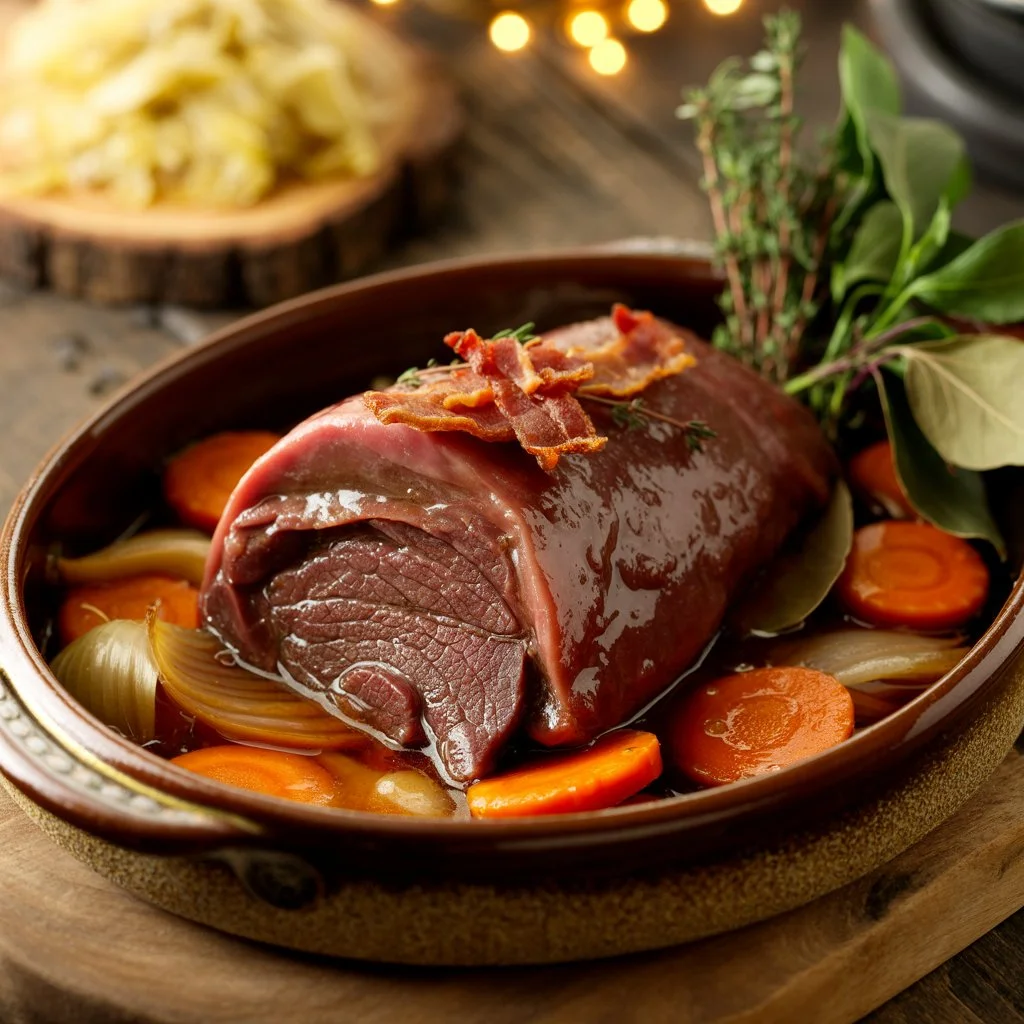
Step-by-Step Instructions
Step 1: Initial Tongue Preparation
Place the beef tongue in a large stockpot and cover completely with cold water. Bring to a rolling boil over high heat, then reduce to maintain steady boiling for 1.5 hours. This preliminary cooking phase softens the outer membrane and begins breaking down tough fibers, creating the foundation for subsequent braising success.
Step 2: Skin Removal Process
Remove the tongue from boiling water using tongs and transfer to a cutting board. Allow cooling for 10-15 minutes until comfortable to handle. Using a sharp paring knife, carefully peel away the outer skin and trim visible fat deposits. The skin should release easily when properly cooked, revealing smooth, pale meat underneath.
Step 3: Oven Preparation and Vegetable Foundation
Preheat your oven to 325°F (165°C) for optimal braising temperature. In a heavy-bottomed Dutch oven or braising pan, arrange sliced carrots, chopped onions, bacon rinds, and bouquet garni to create an aromatic vegetable bed that will infuse the tongue with complex flavors during cooking.
Step 4: Wine Reduction Technique
Place the peeled tongue atop the vegetable mixture and pour white wine around the ingredients. Bring to a gentle simmer over medium heat and allow the wine to reduce by one-third, concentrating flavors and removing excess alcohol. This reduction process typically requires 8-10 minutes of careful monitoring.
Step 5: Liquid Addition and Braising Setup
Add reserved cooking liquid from the initial boiling phase along with an equal volume of beef broth to create optimal braising environment. The liquid should reach approximately two-thirds up the tongue’s height, ensuring proper moisture retention throughout the cooking process.
Step 6: Oven Braising Process
Cover the Dutch oven with a tight-fitting lid and transfer to the preheated oven. Braise for 1.5-2 hours, checking periodically to ensure consistent liquid levels. The tongue reaches optimal tenderness when easily pierced with a fork and internal temperature reaches 160°F.
Step 7: Sauce Development
Remove the tongue from braising liquid and set aside under aluminum foil. Strain the braising liquid through fine mesh into a saucepan, discarding solids. Reduce the liquid over medium-high heat to one-third original volume, creating concentrated flavor base for the finishing sauce.
Step 8: Sauce Thickening and Final Preparation
Incorporate demi-glace or arrowroot slurry into the reduced braising liquid, whisking continuously to prevent lumps. The sauce should coat the back of a spoon when properly thickened. Taste and adjust seasoning as needed before serving.
Nutritional Information
Braised beef tongue provides exceptional nutritional density, delivering comprehensive micronutrient profiles often absent in conventional meat cuts:
Per 4-ounce serving:
- Calories: 250
- Protein: 22 grams (44% daily value)
- Fat: 16 grams (primarily monounsaturated)
- Carbohydrates: 2 grams
- Iron: 3.2mg (18% daily value)
- Zinc: 4.1mg (37% daily value)
- Vitamin B12: 2.8mcg (117% daily value)
- Folate: 8mcg (2% daily value)
Beef tongue contains exceptional concentrations of CoQ10, essential for cellular energy production, and provides complete amino acid profiles necessary for muscle maintenance and repair. The high B-vitamin content supports nervous system function and energy metabolism.
Healthier Alternatives for the Recipe
Transform this classic preparation into a lighter, more nutritious version while maintaining authentic flavors and textures:
Reduced Sodium Approach: Replace bacon rinds with herb-crusted mushrooms or roasted bell peppers to decrease sodium content while adding umami depth. Fresh herbs can substitute for bouquet garni, providing similar aromatic benefits without processed ingredients.
Lower Fat Modification: Trim visible fat more aggressively during preparation and skim braising liquid multiple times during cooking. Substitute heavy cream-based sauces with yogurt-based alternatives or vegetable purees for similar richness with reduced saturated fat content.
Enhanced Vegetable Integration: Double the vegetable quantities to increase fiber content and create more substantial, nutrient-dense servings. Root vegetables like parsnips, turnips, and celery root add complexity while boosting vitamin and mineral profiles.
Alcohol-Free Adaptation: Replace white wine with mushroom broth or vegetable stock enhanced with grape juice for similar acidity and depth without alcohol content. This modification maintains flavor complexity while accommodating dietary restrictions.
Serving Suggestions
Present braised beef tongue with sophisticated accompaniments that complement its rich, savory profile while providing textural contrast:
Traditional Alsatian Presentation: Serve sliced tongue over warm sauerkraut with roasted root vegetables and crusty bread. This classic combination balances the meat’s richness with tangy, fermented flavors and provides authentic cultural context.
Modern Plating Approach: Slice the tongue into medallions and arrange over creamy polenta or cauliflower puree. Drizzle with reduced braising sauce and garnish with microgreens or fresh herbs for contemporary fine-dining presentation.
Comfort Food Adaptation: Shred the tongue and incorporate into hearty stews, pasta dishes, or grain bowls. The tender meat integrates seamlessly into familiar preparations while introducing new flavors and textures.
Sandwich Applications: Thinly slice cold braised tongue for gourmet sandwiches paired with horseradish cream, pickled vegetables, and artisanal bread. This preparation showcases the meat’s versatility beyond traditional hot presentations.
Common Mistakes to Avoid
Successful braised beef tongue preparation requires attention to specific technical details that distinguish exceptional results from mediocre outcomes:
Inadequate Initial Cooking: Rushing the preliminary boiling phase results in difficult skin removal and uneven texture. The tongue requires full 1.5-hour initial cooking to achieve proper tenderness and facilitate clean peeling.
Insufficient Liquid Monitoring: Braising liquid evaporation during oven cooking can cause burning and tough texture. Check liquid levels every 45 minutes and add hot broth if needed to maintain proper moisture levels.
Overcrowding Vegetables: Excessive vegetable quantities prevent proper browning and flavor development. Maintain appropriate ratios to ensure vegetables caramelize rather than steam, contributing optimal flavor to the braising liquid.
Temperature Inconsistencies: Oven temperature fluctuations affect cooking times and texture development. Use an oven thermometer to verify accurate temperature maintenance throughout the braising process.
Premature Sauce Thickening: Adding thickening agents too early can result in lumpy, uneven sauce texture. Always strain braising liquid and reduce before incorporating demi-glace or arrowroot for smooth, professional results.
Storing Tips for the Recipe
Proper storage techniques preserve braised beef tongue’s quality and extend its usability for future meal planning:
Refrigeration Guidelines: Store cooked tongue in braising liquid within sealed containers for up to four days. The liquid prevents drying and maintains flavor integrity while providing convenient reheating medium.
Freezing Protocols: Slice cooled tongue and freeze in individual portions with small amounts of braising sauce. Properly wrapped portions maintain quality for up to three months, providing convenient meal components for busy schedules.
Reheating Techniques: Gentle reheating in braising liquid preserves texture and prevents drying. Use low oven temperatures (275°F) or stovetop simmering to restore serving temperature without compromising quality.
Advance Preparation: Complete initial boiling and peeling up to two days ahead, storing prepared tongue in refrigerator until ready for braising. This technique streamlines final preparation while maintaining optimal results.
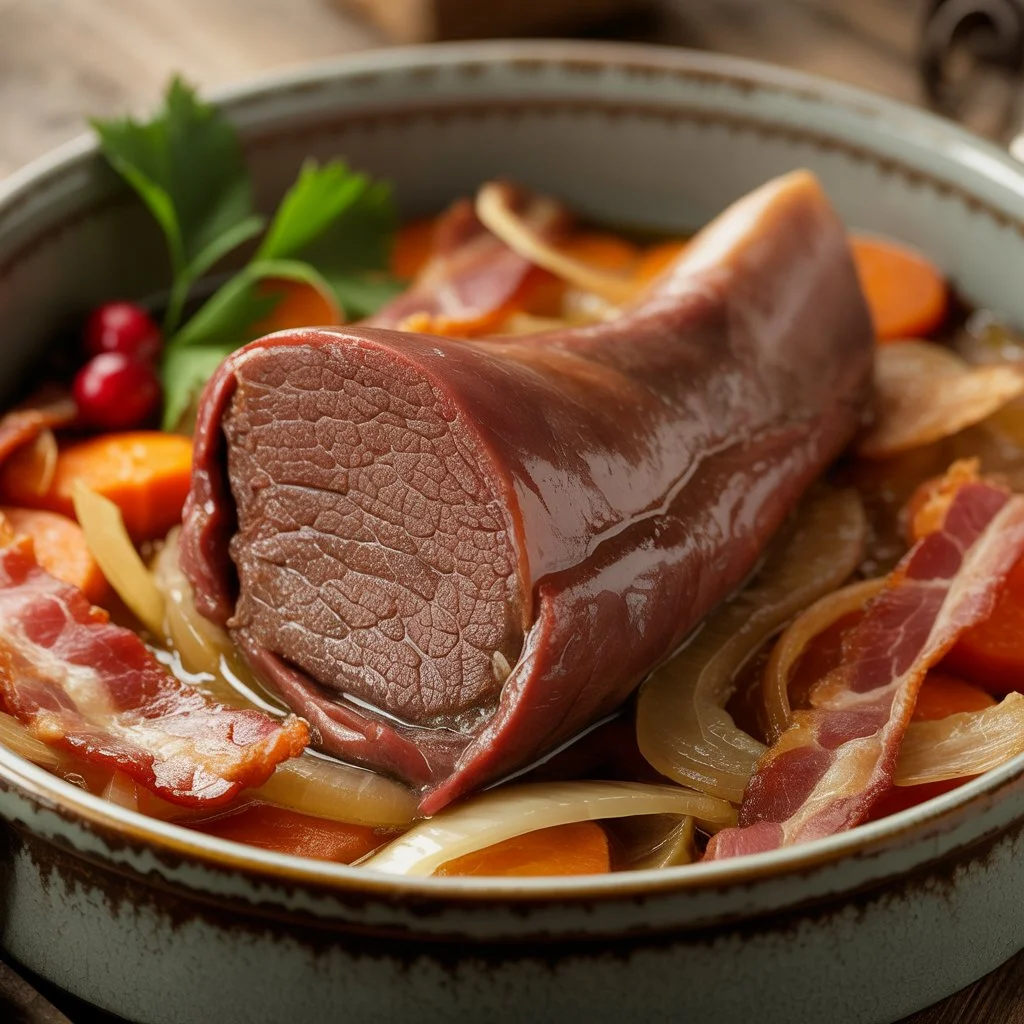
Conclusion
Braised beef tongue represents culinary excellence through traditional techniques that transform humble ingredients into restaurant-quality dining experiences. This comprehensive guide provides the knowledge and confidence necessary to master this sophisticated preparation, delivering exceptional nutritional benefits alongside remarkable flavors that challenge conventional perceptions about organ meats.
Ready to embark on your braised beef tongue journey? Try this recipe and share your results in the comments below. Subscribe to our blog for more adventurous cooking techniques and traditional recipes that bring gourmet dining to your home kitchen.
FAQs
Q: Can I prepare braised beef tongue without wine? A: Yes, substitute white wine with additional beef stock or mushroom broth enhanced with a tablespoon of white wine vinegar for similar acidity and depth.
Q: How do I know when the tongue is properly cooked? A: Properly braised tongue should reach an internal temperature of 160°F and pierce easily with a fork. The meat should feel tender when pressed gently.
Q: What’s the best way to slice braised beef tongue for serving? A: Slice against the grain in 1/4-inch thick medallions using a sharp carving knife. This technique ensures maximum tenderness and attractive presentation.
Q: Can I make this recipe in a slow cooker? A: While possible, slow cooker preparation requires modifications to liquid ratios and cooking times. The oven braising method provides superior flavor development and texture control.
Q: How long can I store leftover braised beef tongue? A: Properly stored braised tongue remains fresh in the refrigerator for up to four days or frozen for three months when wrapped appropriately with braising liquid.
Q: Is beef tongue safe to eat? A: Yes, beef tongue from reputable sources is completely safe when cooked to proper internal temperatures. The preliminary boiling and braising process ensures food safety while developing optimal texture and flavor.
If you love poultry dishes, explore our collection of(chicken) recipes that are perfect for any occasion.
